

Fun With Food and Fitness — Newsletter for First Grade Curriculum Lesson 7: Protein (Bundle of 25)
Reviewed $12
Editor's note
The following abstract describes a publication that is available for purchase or as a downloadable PDF.
If reprinting or copying, please complete the permissions form that can be found on the reprint and copy guidelines page. If sharing or posting, please link directly to this page.

Choosing Foods for Me - Newsletter for Fourth Grade Curriculum Lesson 7: Eating Out (Bundle of 25)
Revised $12
Editor's note
The following abstract describes a publication that is available for purchase or as a downloadable PDF.
If reprinting or copying, please complete the permissions form that can be found on the reprint and copy guidelines page. If sharing or posting, please link directly to this page.

Food Group Express — Newsletter for Second Grade Curriculum Lesson 2: Whole Grains (Bundle of 25)
Reviewed $12
Editor's note
The following abstract describes a publication that is available for purchase or as a downloadable PDF.
If reprinting or copying, please complete the permissions form that can be found on the reprint and copy guidelines page. If sharing or posting, please link directly to this page.

Choosing Foods for Me — Newsletter for Fourth Grade Curriculum Lesson 10: Hunger (Bundle of 25)
Reviewed $12
Editor's note
The following abstract describes a publication that is available for purchase or as a downloadable PDF.
If reprinting or copying, please complete the permissions form that can be found on the reprint and copy guidelines page. If sharing or posting, please link directly to this page.

Food Group Express — Newsletter for Second Grade Curriculum Lesson 5: Dairy (Bundle of 25)
Revised $12
Editor's note
The following abstract describes a publication that is available for purchase or as a downloadable PDF.
If reprinting or copying, please complete the permissions form that can be found on the reprint and copy guidelines page. If sharing or posting, please link directly to this page.
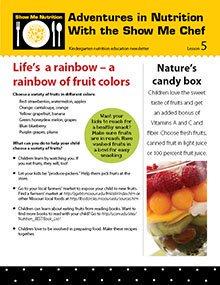
Adventures in Nutrition With the Show Me Chef — Newsletter for Kindergarten Curriculum Lesson 5: Fruit (Bundle of 25)
Reviewed $12
Editor's note
The following abstract describes a publication that is available for purchase or as a downloadable PDF.
If reprinting or copying, please complete the permissions form that can be found on the reprint and copy guidelines page. If sharing or posting, please link directly to this page.
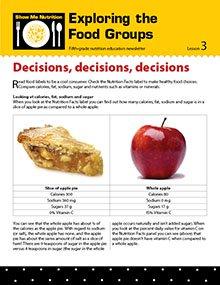
Exploring the Food Groups — Newsletter for Fifth Grade Curriculum Lesson 3: Reading the Nutrition Facts Label (Bundle of 25)
Reviewed $12
Editor's note
The following abstract describes a publication that is available for purchase or as a downloadable PDF.
If reprinting or copying, please complete the permissions form that can be found on the reprint and copy guidelines page. If sharing or posting, please link directly to this page.
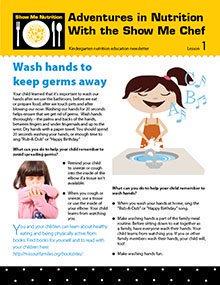
Adventures in Nutrition With the Show Me Chef — Newsletter for Kindergarten Curriculum Lesson 1: Hand Washing (Bundle of 25)
Reviewed $12
Editor's note
The following abstract describes a publication that is available for purchase or as a downloadable PDF.
If reprinting or copying, please complete the permissions form that can be found on the reprint and copy guidelines page. If sharing or posting, please link directly to this page.
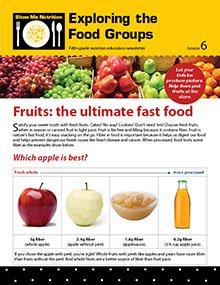
Exploring the Food Groups — Newsletter for Fifth Grade Curriculum Lesson 6: Fruits (Bundle of 25)
Reviewed $12
Editor's note
The following abstract describes a publication that is available for purchase or as a downloadable PDF.
If reprinting or copying, please complete the permissions form that can be found on the reprint and copy guidelines page. If sharing or posting, please link directly to this page.

Adventures in Nutrition With the Show Me Chef — Newsletter for Kindergarten Curriculum Lesson 6: Dairy (Bundle of 25)
Reviewed $12
Editor's note
The following abstract describes a publication that is available for purchase or as a downloadable PDF.
If reprinting or copying, please complete the permissions form that can be found on the reprint and copy guidelines page. If sharing or posting, please link directly to this page.

Exploring the Food Groups — Newsletter for Fifth Grade Curriculum Lesson 9: Snacks (Bundle of 25)
Reviewed $12
Editor's note
The following abstract describes a publication that is available for purchase or as a downloadable PDF.
If reprinting or copying, please complete the permissions form that can be found on the reprint and copy guidelines page. If sharing or posting, please link directly to this page.
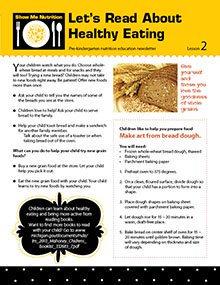
Lets Read About Healthy Eating — Newsletter for Pre-kindergarten Curriculum Lesson 2: Breads (Bundle of 25)
Reviewed $12
Editor's note
The following abstract describes a publication that is available for purchase or as a downloadable PDF.
If reprinting or copying, please complete the permissions form that can be found on the reprint and copy guidelines page. If sharing or posting, please link directly to this page.

Building MyBody — Newsletter for Third Grade Curriculum Lesson 1: Getting to know MyPlate (Bundle of 25)
Reviewed $12
Editor's note
The following abstract describes a publication that is available for purchase or as a downloadable PDF.
If reprinting or copying, please complete the permissions form that can be found on the reprint and copy guidelines page. If sharing or posting, please link directly to this page.
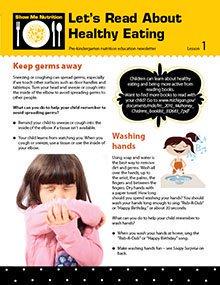
Let's Read About Healthy Eating — Newsletter for Pre-kindergarten Curriculum Lesson 1: Hand Washing (Bundle of 25)
Revised $12
Editor's note
The following abstract describes a publication that is available for purchase or as a downloadable PDF.
If reprinting or copying, please complete the permissions form that can be found on the reprint and copy guidelines page. If sharing or posting, please link directly to this page.
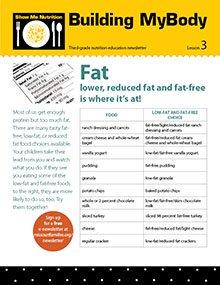
Building MyBody — Newsletter for Third Grade Curriculum Lesson 3: Fat (Bundle of 25)
Reviewed $12
Editor's note
The following abstract describes a publication that is available for purchase or as a downloadable PDF.
If reprinting or copying, please complete the permissions form that can be found on the reprint and copy guidelines page. If sharing or posting, please link directly to this page.

Let's Read About Healthy Eating — Newsletter for Pre-kindergarten Curriculum Lesson 7: MyPlate (Bundle of 25)
Reviewed $12
Editor's note
The following abstract describes a publication that is available for purchase or as a downloadable PDF.
If reprinting or copying, please complete the permissions form that can be found on the reprint and copy guidelines page. If sharing or posting, please link directly to this page.

Building MyBody — Newsletter for Third Grade Curriculum Lesson 6: Body Cues (Bundle of 25)
Reviewed $12
Editor's note
The following abstract describes a publication that is available for purchase or as a downloadable PDF.
If reprinting or copying, please complete the permissions form that can be found on the reprint and copy guidelines page. If sharing or posting, please link directly to this page.

Let's Read About Healthy Eating — Newsletter for Pre-kindergarten Curriculum Lesson 10: Dental Health (Bundle of 25)
Reviewed $12
Editor's note
The following abstract describes a publication that is available for purchase or as a downloadable PDF.
If reprinting or copying, please complete the permissions form that can be found on the reprint and copy guidelines page. If sharing or posting, please link directly to this page.

Choosing Foods for Me — Newsletter for Fourth Grade Curriculum Lesson 2: Dairy and Protein (Bundle of 25)
Reviewed $12
Editor's note
The following abstract describes a publication that is available for purchase or as a downloadable PDF.
If reprinting or copying, please complete the permissions form that can be found on the reprint and copy guidelines page. If sharing or posting, please link directly to this page.

Choosing Foods for Me — Newsletter for Fourth Grade Curriculum Lesson 5: The Nutrition Facts Label (Bundle of 25)
Revised $12
Editor's note
The following abstract describes a publication that is available for purchase or as a downloadable PDF.
If reprinting or copying, please complete the permissions form that can be found on the reprint and copy guidelines page. If sharing or posting, please link directly to this page.

Adventures in Nutrition With the Show Me Chef — Newsletter for Kindergarten Curriculum Lesson 7: Protein (Bundle of 25)
Reviewed $12
Editor's note
The following abstract describes a publication that is available for purchase or as a downloadable PDF.
If reprinting or copying, please complete the permissions form that can be found on the reprint and copy guidelines page. If sharing or posting, please link directly to this page.

Fun With Food and Fitness — Newsletter for First Grade Curriculum Lesson 8: Food Groups (Bundle of 25)
Reviewed $12
Editor's note
The following abstract describes a publication that is available for purchase or as a downloadable PDF.
If reprinting or copying, please complete the permissions form that can be found on the reprint and copy guidelines page. If sharing or posting, please link directly to this page.

Choosing Foods for Me — Newsletter for Fourth Grade Curriculum Lesson 8: Food Safety (Bundle of 25)
Reviewed $12
Editor's note
The following abstract describes a publication that is available for purchase or as a downloadable PDF.
If reprinting or copying, please complete the permissions form that can be found on the reprint and copy guidelines page. If sharing or posting, please link directly to this page.
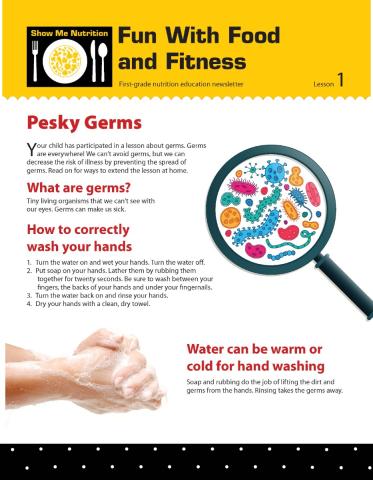
Fun With Food and Fitness — Newsletter for First Grade Curriculum Lesson 1: Pesky Germs (Bundle of 25)
Reviewed $12
This newsletter corresponds with Lesson 1 of the Show Me Nutrition First Grade curriculum. Learn the importance of hand washing to avoid illness.
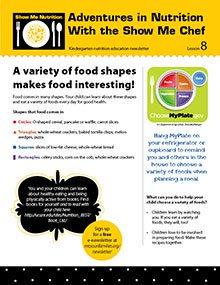
Adventures in Nutrition With the Show Me Chef — Newsletter for Kindergarten Curriculum Lesson 8: Adventures in Healthy Eating (Bundle of 25)
Reviewed $12
Editor's note
The following abstract describes a publication that is available for purchase or as a downloadable PDF.
If reprinting or copying, please complete the permissions form that can be found on the reprint and copy guidelines page. If sharing or posting, please link directly to this page.